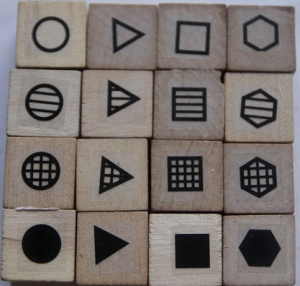If you’ve seen Block Party, you’ve also encountered at least one set of BP glyphs.

V1 glyphs
A glyph (or symbol) in Block Party for all those interested is composed of three independent attributes which each take on one of 4 possible values. in the original design this manifested as shape, fill, and color taking on values in {circle, triangle, square, pentagon}, {empty, striped, crosshatched, solid}, and {red, blue, green, black} respectively.
After playing with those glyphs for a bit we started to realize that there were probably better ways to design them so that each feature was easier to see. We swapped put the pentagon for a hexagon, which we then swapped out for a star.

V2 Originals
We also changed striped and crosshatched to shape-in-shape and tessellated to realize that those fills (while more aesthetically pleasing) were harder for people to learn on. One other experiment we tried was changing the fill to an inside color, which was far more difficult even for more practiced players.
From these experiments we’ve noticed a few factors which are important to measure for new glyph designs: learnability, differentiability, and perceptual ease. Learnability is a measure of how long it takes someone new to find their first party, a distribution with a mean which we’d like to minimize.

V2.C: color-in-color
For differentiability, consider the experiment where a subject is shown two glyphs and must press one of two buttons, same or different. We want to minimize the maximum time this takes. For perceptual ease, we’d like to make each attribute so as to minimize T, where T is the maximum result if someone were just looking for parties of one variety (e.g. just same color, just same shape, just same fill, etc.) for each variety. (For reference, I currently find a same-color party in less than 20 seconds on average, and same-fill party in about 30 seconds on V2.) For a examples of glyphs which make this kind of separation difficult, check out the 16 ‘black’ V2 and V2.C symbols. (To obtain the different colors in V2.C, the outlines of the symbols are changed to be one of the 4 inside colors.)
We’re still working on our designs and will post future ones as we come up with them. In the meantime, if you have ideas and suggestions feel free to comment below or email them to g at 3pxh.com, we’d be delighted to hear your thoughts.